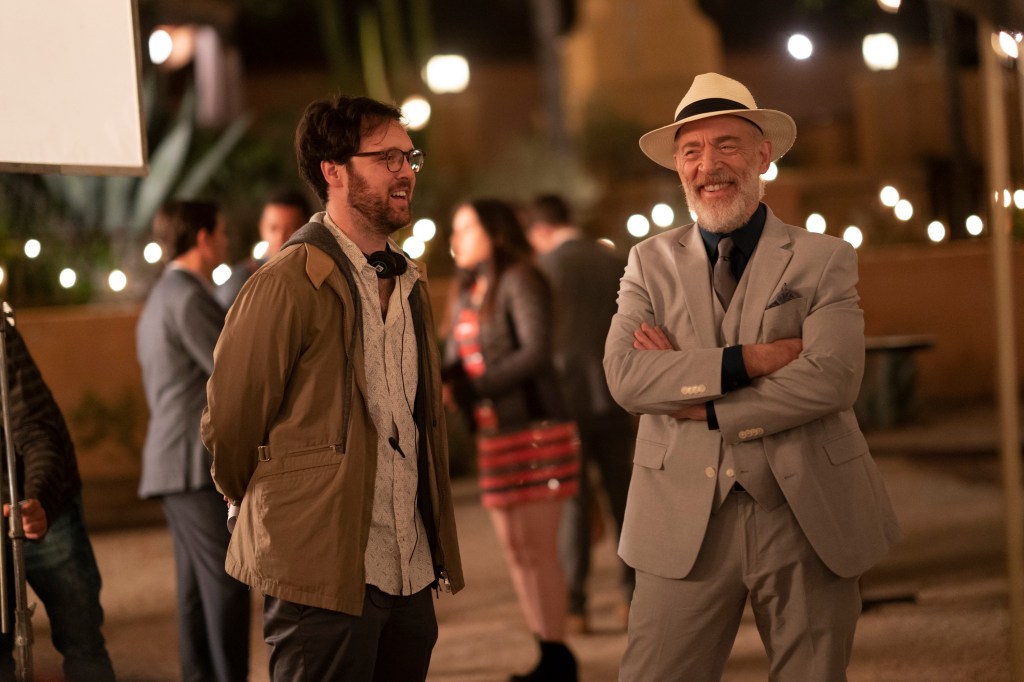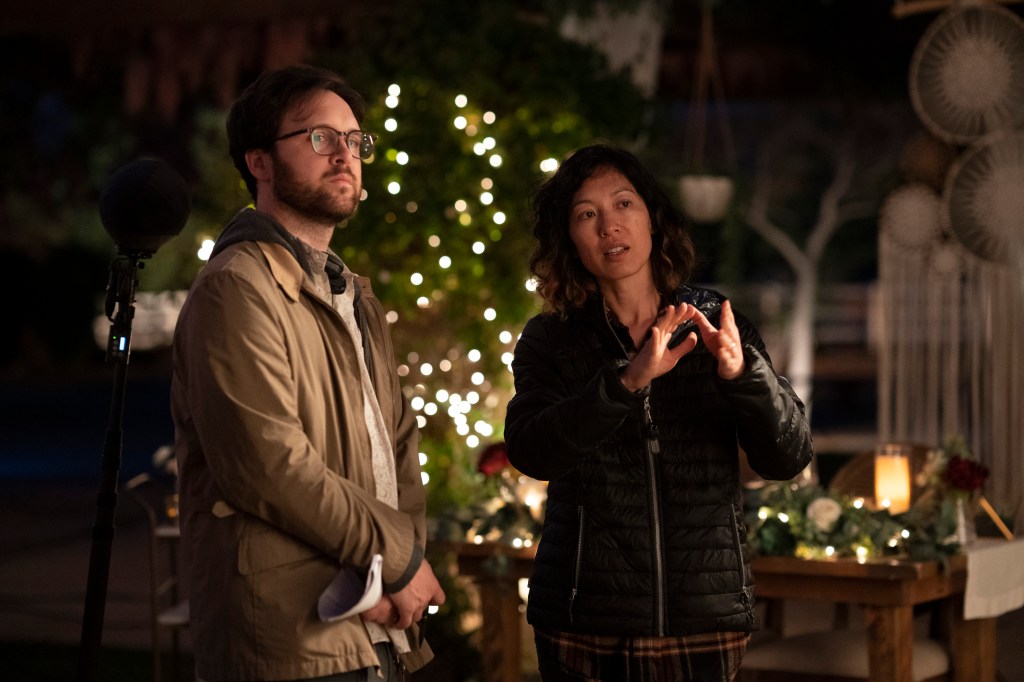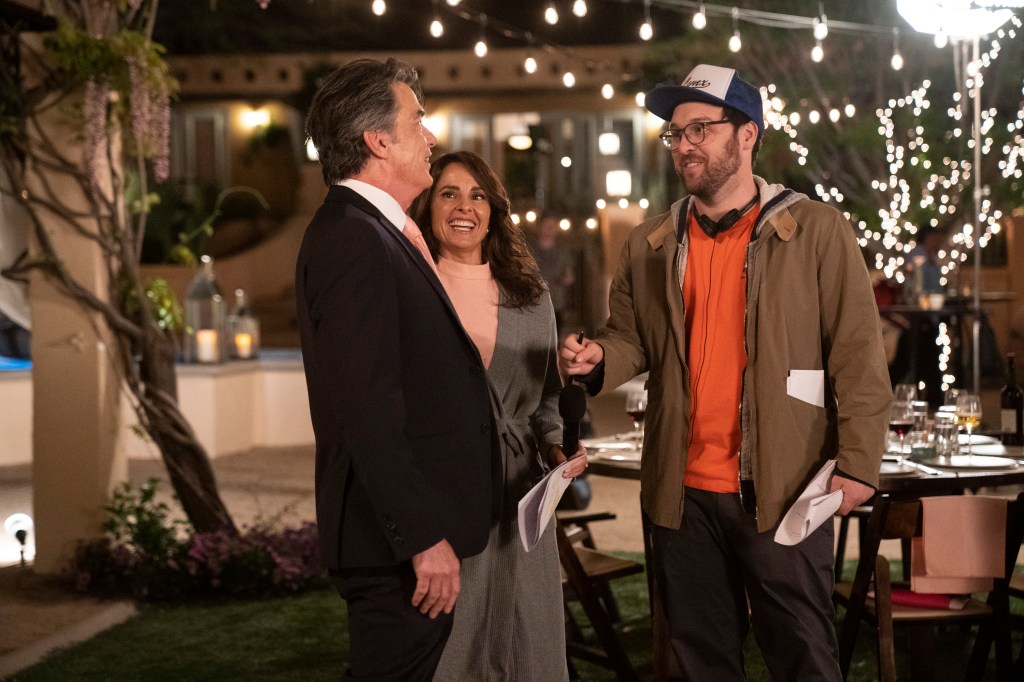‘Palm Springs’ Director Max Barbakow Interviewed
Deliciously Eccentric, Faux Mainstream Film Throws Audience for Loop After Loop
By Josef Woodard | Published July 30, 2020

One thing to know about the deliciously eccentric, faux mainstream film Palm Springs is that it throws us for a loop. And then another and another. The film begins innocently enough, with Judd Apatow-esque comic ribaldry as a wedding in Palm Springs begins to go wrong in various ways. Star power is in the house, with SNL’s Andy Samberg and love interest Cristin Milioti (How I Met Your Mother, FX’s Fargo) circling around the scent of forbidden love.
Lest we get too comfortable in the embrace of a rom-com formula, however, the plot quickly thickens — in ways that anti-plot spoilers among us are hesitant to get into. Suffice it to say, the story’s time-space continuum goes awry, sci-fi sauce mixes with bravura genre-mashing, and dollops of subversive cinematic ideas are tossed into the stew. Et voilà: We have a thinking person’s feel-good summer hit. “Sensation” might be a better description, as the film garnered a record acquisition prize (more than $17.5 million, from Hulu and Neon distribution) when it premiered at Sundance Festival earlier this year, and the film had a record-breaking bonanza of streamers on its recent opening weekend on Hulu.
Adding to the buzz is a matter of civic pride — homegrown Santa Barbaran Max Barbakow directed and created the winning film with screenwriter Andy Siara, his friend from the American Film Institute (AFI). Barbakow is a familiar name in Santa Barbara’s film-culture scene thanks to his family’s deep involvement with the Santa Barbara International Film Festival (SBIFF); his father, Jeffrey Barbakow, was SBIFF president for six years, and the family name adorns the organization’s Barbakow Family Center for Film Studies. Prior to Palm Springs, the 31-year-old filmmaker made a documentary about his life as an adoptee called Mommy, I’m a Bastard!, which premiered at the 2013 SBIFF.
Barbakow studied at AFI (class of 2015) and Yale, and had a stint working with iconic German-gone-Los Angeleno director Werner Herzog. His subsequent IMDb profile includes The Duke: Based on the Memoir ‘I’m the Duke’ by J.P. Duke in 2016, and the 2017 short Mi Dulcinea.
Palm Springs is Barbakow’s introduction into the Hollywood big leagues. With this auspicious feature-film debut, Barbakow instantly joins the ranks of internationally noted Santa Barbara–raised directors, including Mike Mills (the S.B.-related 20th Century Women and Beginners), and Taylor Hackford (An Officer and a Gentleman, Hail! Hail! Rock and Roll!, Ray).
I spoke over the phone with Barbakow just after the Hulu salvo bumped him ever higher up the ranks of what’s new and who’s who in American film.

Max Barbakow behind the scenes on the set of Palm Springs. 
Academy Award-winning actor J.K. Simmons (right), who plays Roy in Director Max Barbakow’s film Palm Springs. 
Director Max Barbakow (left) and cinematographer Quyen Tran on the Palm Springs set. 
Behind the scenes on the set of Palm Springs.
This year would seem to be a banner one for you — despite the ongoing struggles of COVID-19. Your record-breaking responses at Sundance and on Hulu suggest a delicious double whammy. Does this feel like a whirlwind moment and a launching point for your life as a director?
It’s been an incredible time on a personal level, but obviously quite devastating for our country and the world. Our film is really small potatoes in the scope of this challenging moment, but hopefully it allows people to escape for 90 minutes and laugh. Personally, it’s definitely been a whirlwind ride. It’s extremely gratifying that people are responding to the film.
I was preparing to feel some of those postpartum blues after putting Palm Springs out into the world — after living with an idea for so long, realizing it, and releasing it, the movie no longer exclusively belongs to me — but the way people have engaged and started discussing its meaning extended the ride a bit. It’s been really special.
Life during the pandemic has really shaken up the arts, both performing and the screen arts. How have you weathered this period? Are you a work-at-homer, and are there positives to the forced isolation of life now?
Honestly, the forced isolation is a boon to me in a creative sense. I’m a work-at-homer when I’m not on set, and right now am generally back in the gestation stage with projects, so I’ve been able to bear down and write/prep stuff, read and develop some more, too.
I also proposed to my now-fiancée, which provided a little shot in the arm for us at home, and we have a rascally new puppy to keep things interesting, as well. Aside from the inherent suffering in our collective national pause, I do think taking a beat and sitting with ourselves, thinking about how to reframe our priorities and rebuild the world, is an incredible opportunity.
I was really dazzled by Palm Springs — maybe due to little shocks of recognition in that I have attended a wedding in that gilded desert outpost and noted the surrealist potential. Andy Siara’s screenplay morphed from the version he wrote while at AFI with you. How long has this project been brewing with you two, and has it changed shape and direction a lot along the way?
We actually started working on the project after we finished AFI. We decided we wanted to make a feature together and keep the productivity from film school going while rediscovering some of our instincts. We took a drive out to Palm Springs for a weekend brainstorm and came home with the basic idea for Nyles’s character.
That was almost five years ago, and while the story evolved from an absurdly comic, existentialist, mumblecore death bender movie into the love story you see now, the tone and the energy at its core — Andy and I in a room, trying to make each other laugh, trying to understand more about ourselves, our relationships, and make sense of a confusing world — remained consistent throughout.

Did the project really grow wings and get wider attention once Andy Samberg got involved, and how was the creative working process with him?
He immediately made the project “real” and gave us a chance to get financed. When you have Andy Samberg starring and producing your film, other talented people want to get involved. And working with Samberg was a dream collaboration. From the first time we met, it was clear we saw the same movie — tonally, comedically, energy-wise — and he helped us make it way better during the time we spent working on the script together.
Then, when I went to shoot it and the machine got bigger, he was supportive every step of the way, protecting the essence of the movie and teeing me up to do my best work. I tried to return the favor.
Palm Springs seems to live in a place similar to the wonderful film Parasite, in that both somehow blend elements and attitudes of both art films and popcorn movies. Was that a conscious goal for you and Andy Siara, to find that tricky balance?
We tried to turn that critical voice off throughout the writing of it, not overthinking where our sensibilities were leading us. But, yes, I would say that blend of tone and scope is right where our authentic sensibilities reside. I would also say Anomalisa and Jurassic Park were two big and very disparate references.
You manage to fuse genres organically — the Murphy’s Law–afflicted wedding story, time-loop cinema, aspects of rom-com — with genuine romantic magnetism between the central couple. And even references to the multiverse and quantum physics come together, all in a package that is now being screened at U.S. drive-ins. How did you get away with it?
That was the most exciting challenge to tackle with Palm Springs. I figured we could get away with the genre playfulness by keeping the human threads of the story — Nyles and Sarah — grounded and prominent. Andy Siara and I spent a lot of time creating fully fleshed-out, emotionally messy, dynamic characters to keep the story relatable throughout its more heightened madness. I always hoped they would be our anchors.
Speaking of famed SoCal cities, can you reflect on your life growing up in Santa Barbara, and how that might have shaped or colored your outlook and approach as a filmmaker?
It’s paradise. I love it so much. But being aware of that, I made it a priority to travel a lot as I grew up, to collect experiences outside of SoCal, to meet people, get into (good) trouble, have adventures, all in an attempt to force myself outside of a comfort zone and figure out who I was and develop something to say. But definitely, growing up in Santa Barbara and going to SBIFF — seeing amazing cinema from all around the world, seeing incredible artists speak on panels — was extremely integral to me finding myself as a filmmaker.
When did the notion of becoming a director enter your life, and take over your vision of a future?
My brother Bennett, who I idolize and work with and is the most talented creative I know, turned me on to all the directors coming into their own in the ’90s, so that’s when I fell in love with film and the idea of being a filmmaker. I was probably about 8 [years old] and seeing those films way too young, but by the time high school came around, I really started consuming and making shorts in a more dedicated way.
I notice in your bio that you studied with Werner Herzog, who I know has some pretty radical views about film, and about film theory. What was your takeaway from your encounter with him?

“Invent! Invent! Invent!” And “conspire.” Those are words Werner loves. While my time at AFI was all about taking emotional inventory and telling personal stories that were very well thought-out and made on larger-scale sets, Werner works from an opposite place. When I was in Cuba with him, he preached searching for an “ecstatic truth” by not overthinking your creativity and working outside-in, conspiring with your surroundings to invent story as you go, guerilla style. That time with him very much allowed me to regain a lot of my instincts that had been dulled by overthinking the craft at AFI.
Who would you put on a short list of favorite and/or influential directors?
First and enduring loves: Paul Thomas Anderson, Coen brothers, Steven Soderbergh, Spike Jonze. Also: Hal Ashby, Mike Nichols, Stanley Kubrick.
Your doc, Mommy, I’m a Bastard, premiered at the 2013 SBIFF, after which your larger life as a filmmaker expanded. It’s such an original and very personal project, about being adopted, and also a statement about the fluidity of definitions of family, more generally. How do you look back on that film at this juncture, seven years later?
I learned how to make a film with the movie. I wrote, shot, and edited it myself without really knowing what I was doing, which is why it feels so unique and full of that energy of discovery and self-discovery. I wasn’t experienced enough to know what made sense throughout the process of making it. In that way, it was an incredibly liberating feeling, also cathartic on a personal level.
I actually recently realized that with everything I do, I’m trying to recapture the magic of making Bastard, just being in the moment and open-minded and laying it all out in the frame. It was so fun to make.
I love the last scene, in which your parents and brother are engaged in funny, pile-up horseplay, but you pass on hopping into the pile, saying, “I like to watch.” Without making too much of a symbolic point of it, is that indicative of your general attitude as an artist and person — preferring the role of observer and behind-the-scenes artist versus seizing spotlights?
That was such a spontaneous moment! I’m not that passive or shy, but I do prefer to let the work speak for itself, and, as a director, I love putting collaborators in positions to do their best work. It helps when you have co-conspirators — in that moment, my wonderful family, who are game to get weird and take ownership over your idea and make it better.

You’re set to direct a film called Good Bad & Undead, with Peter Dinklage. Can you give us a hint of what that’s about, and is it forestalled by the pandemic?
Similar to Palm Springs, it’s a pretty fun and offbeat two-hander set in a heightened, genre-fluid world. I’m really excited about what we have brewing, and hopefully we can go make it once there’s some clarity with the pandemic. I’m also doing a bigger-scale project with Andy Siara that’s going to build on our collaboration — that’ll be announced soon.
As you embark on your higher-profile life in film, do you have a sense of what you’d ideally like to achieve in your work? Do you like this idea of creating commercially viable films that maintain an artistic edge, à la Palm Springs?
I do like that idea! I will say that I never had any ambition for our strange little flick becoming commercially viable, but now that it is, I definitely feel encouraged to keep doing the work the way I know how. Where does that lead? No clue. But it’s all been so special and surprising, and I guess I want to continue to surprise myself, to stretch myself, to work to keep myself interested in new things.
I had a mentor who always said, “Have the courage of your peculiarities.” As long as I can tell stories in new ways with the people I love and hold a mirror up to the world in a small way, I’ll be happy.
Palm Springs, directed by Max Barbakow, is available on Hulu and in drive-ins countrywide. To watch Mommy, I’m a Bastard, see tinyurl.com/mommy-bastard.




You must be logged in to post a comment.